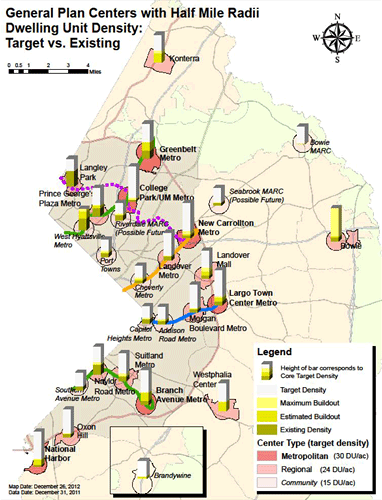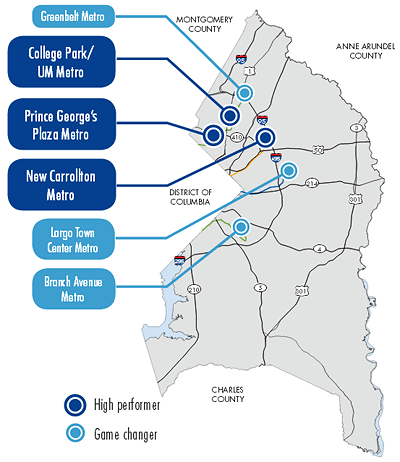Where is downtown Prince George’s County?
Prince George’s County has struggled to attract new development, especially around its Metro stations, but it also lacks a defined center. Over 300 residents and constituents gathered for a town hall meeting at the University of Maryland last Saturday to discuss potential locations for the county’s future “downtown.”
The forum was the latest in a series of outreach efforts by the Maryland-National Capital Park and Planning Commission (M-NCPPC) as part of Plan Prince George’s 2035, an effort to update the county’s General Plan, last updated in 2002.
Over the past 6 months, county planners have worked with residents, business owners, developers and state and municipal officials to craft a vision for the county’s future. They’ve concluded that the county’s approach to development needs to change: instead of sprawling farther out, it must focus on a few select areas that have the transit and economic strength to draw private investment.
The problem: the county can’t simultaneously develop 27 centers
One issue is that the current vision is too broad. The 2002 General Plan designates 27 growth centers. 15 are at each of the county’s Metro stations, and another 3 are at the Bowie, Seabrook and Riverdale MARC stations. 9 other centers are far from existing or planned rail transit, in places like National Harbor, Konterra and Westphalia.
This isn’t serving the county well, says M-NCPPC planner-coordinator Sonja Ewing. Virtually all of the centers remain undeveloped, and none have reached their housing and employment density targets.
Each center fits into one of 3 vague categories, “Metropolitan,” “Regional,” and “Community,” but those often lead to competing and disjointed planning efforts. This time around, M-NCPPC proposes to adopt a more descriptive system with 8 categories. Each one comes with its own particular desired land use mix, desired types of housing, height limits, maximum floor-area ratios, and density limits.
M-NCPPC will also designate 2 or 3 of the “urban center” locations as “Priority Improvement Districts” (PIDs), where the county would provide marketing, infrastructure investments and financial incentives to encourage private development.
Planners pick 3 “high performers” and 3 “game changers”
After analyzing and scoring all 27 areas, Planners chose 6 potential downtown sites, all of which are at Metro stations. They say 3 of them, Prince George’s Plaza, College Park, and New Carrollton, are “high performers” best poised for the PID designation because of the existing level of activity there.
The other 3, which they dubbed “game changers,” need an additional push to make them viable downtowns. These sites are Greenbelt, which could be the FBI’s future home, Largo Town Center, where the county wants to see a regional medical center, and Branch Avenue, where WMATA has expressed interest in a public-private partnership to build around the station.
The audience favored New Carrollton as the best “high performer,” followed by College Park. The audience appeared to favor College Park as the best “high performer” due to the presence of the University of Maryland. There was also clear consensus that New Carrollton made sense as a downtown since it is already a major regional multimodal transportation hub. Largo Town Center was the most-favored “game changer” location.
I left the town hall meeting with several questions, which I hope can receive some attention as we move through the Plan Prince George’s 2035 process. In the next part, I’ll look at those questions.



